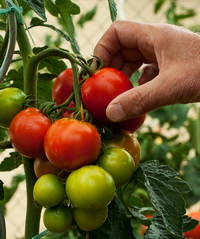
Geneticists Use CRISPR to Correct Tomato Breeding Conflict
May 24, 2017| |
 In the 1950s, scientists found a wild tomato relative in the Galapagos Island that does not have a swollen part of the stem referred to as joint. Joints are the weak parts of the stem that make the fruit fall easily from the plant. Breeders then developed jointless tomatoes to prolong the stay of the fruits in the plants. However, when the jointless tomato was bred with the existing tomato varieties, the resulting plants had flower-bearing branches that produced many extra branches and looked like a broom, terminating in a host of flowers. This led to reduced number of fruits.
In the 1950s, scientists found a wild tomato relative in the Galapagos Island that does not have a swollen part of the stem referred to as joint. Joints are the weak parts of the stem that make the fruit fall easily from the plant. Breeders then developed jointless tomatoes to prolong the stay of the fruits in the plants. However, when the jointless tomato was bred with the existing tomato varieties, the resulting plants had flower-bearing branches that produced many extra branches and looked like a broom, terminating in a host of flowers. This led to reduced number of fruits.
Years after, geneticist Zachary Lippman of Cold Spring Harbor Laboratory in New York and other researchers tracked down the gene responsible for the jointless trait and another gene that promotes the formation of a large green cap of leaf-like structures on top of the fruit. Then they used CRISPR-Cas9 to correct the conflict of the traits, leading to tomato plants with different plant architectures,including those with long, spindly flower-bearing branches to bushy, cauliflower-like bunches of flowers, and some with better yields.
Read more from Nature.
| |
Biotech Updates is a weekly newsletter of ISAAA, a not-for-profit organization. It is distributed for free to over 22,000 subscribers worldwide to inform them about the key developments in biosciences, especially in biotechnology. Your support will help us in our mission to feed the world with knowledge. You can help by donating as little as $10.
-
See more articles:
-
News from Around the World
- Global Seed Industry Urged to Innovate to Address Global Challenges
- Scientists Prepare for Biotech Maize and Cotton Field Trials in Kenya
- Geneticists Turn to Engineered Virus and CRISPR to Fight Citrus Disease
- Canadian Parliament Votes Against Mandatory Labeling of GM Foods
- Petition Calls for Indian Government to Approve GM Mustard
- Philippines Leads Southeast Asia in GM Corn Production
- Study Analyzes 17 Years of Modern Biotech News Reporting in the Philippines
- ISAAA 2016 Report Launched in Indonesia
-
Research Highlights
- Silencing of SlPL Gene in Tomato Confers Enhanced Fruit Firmness
- Suppression of OsMADS7 in Rice Endosperm Stabilizes Amylose Content under High Temperature Stress
-
Beyond Crop Biotech
- International Team Publishes Sunflower Genome Sequence
-
From the BICs
- Punjab Government Develops Strategy to Implement Modern Techniques in Pakistan's Agriculture Sector
-
Resources
- Infographic: Global Status of Commercialized Biotech/GM Crops in 2016
-
Plant
- CRISPR-Cas9-mediated Targeted Mutagenesis of GmFT2a Delays Flowering in Soybean
- Geneticists Use CRISPR to Correct Tomato Breeding Conflict
-
Read the latest: - Biotech Updates (December 17, 2025)
- Gene Editing Supplement (December 17, 2025)
- Gene Drive Supplement (February 22, 2023)
-
Subscribe to BU: - Share
- Tweet
